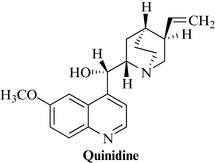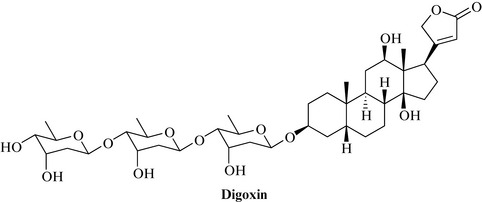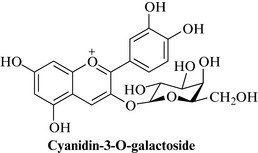Chapter 15 The cardiovascular system
Cardiovascular (CV) disorders are responsible for many deaths in the Western world, and are a consequence of lifestyle and diet, as well as being hereditary to some extent. Serious conditions such as heart failure should be treated only under the guidance of a qualified physician, but some minor forms of CV disease respond well to changes in diet and taking more exercise, as well as phytotherapy. Cardiology has benefited greatly from the introduction of some newer semi-synthetic drugs based on natural products, including aspirin, an antiplatelet agent derived from salicin, and warfarin, an anticoagulant derived from dicoumarol. Others have been developed using a natural product as a template, for example, verapamil, a calcium channel antagonist used to treat hypertension and angina, is based on the opium alkaloid papaverine, and nifedipine, a calcium channel antagonist and amiodarone, an anti-arrhythmic, were both developed from khellin, the active constituent of Ammi visnaga. Cocaine has cardioactive as well as central nervous system effects, and was the starting material for the development of the anti-arrhythmics procaine and lignocaine, which are more effective and without the unwanted stimulant activity (Hollmann 1992).
Cardiovascular conditions discussed here include heart failure, venous insufficiency, thrombosis and atherosclerosis. Other conditions such as hypertension and cardiac arrhythmias are rarely treated with phytomedicines, although there are some natural products used in their treatment which will be mentioned briefly. Synthetic diuretics are widely used as antihypertensives, but phytomedicines are not suitable for this purpose as they are not sufficiently potent to reduce blood pressure. Instead, they are often incorporated into remedies for urinary tract complaints (see Chapter 20) or to reduce bloating (mild water retention, for example pre-menstrual).
Heart failure and arrhythmias
There are, however, other herbal drugs that have beneficial effects upon the heart, the most important of which are hawthorn (Crataegus) and motherwort (Leonurus cardiaca). Hawthorn has anti-arrhythmic activity, and will be discussed briefly below. There is not enough evidence available at present to justify the inclusion of motherwort. In general, however, arrhythmias are treated with isolated compounds, most of which are synthetic, although quinidine (an alkaloid from Cinchona spp.; Fig. 15.1) is still used occasionally. Ajmaline, from Rauvolfia spp., is used as an anti-arrhythmic in some parts of the world; sparteine, from broom (Cytisus scoparius), was formerly employed. Both of these compounds are alkaloids.
Foxglove (digitalis) leaf, Digitalis purpurea L. (Digitalis purpureae folium) 
Constituents
Both species contain cardenolides, which are glycosides of the steroidal aglycones digitoxigenin, gitoxigenin and gitaloxigenin. There are very many cardiac glycosides, but the most important is digoxin (Fig. 15.2) and to a much lesser extent digitoxin, and the purpurea glycosides A and B. Digitalis lanata contains higher concentrations of glycosides, including digoxin and lanatosides, and is the main source of digoxin for the pharmaceutical industry.
Hawthorn, Crataegus spp. (Crataegi folium cum flore, Crataegi fructus) 
Therapeutic uses and available evidence
Hawthorn is used as a cardiac tonic, hypotensive, coronary and peripheral vasodilator, anti-atherosclerotic and anti-arrhythmic. Animal studies have shown beneficial effects on coronary blood flow, blood pressure and heart rate, as well as improved circulation to the extremities (Alternative Medicine Review (Crataegus) 2010). Hawthorn extract inhibits myocardial Na+, K+-ATPase and exerts a positive inotropic effect and relaxes the coronary artery. It blocks the repolarizing potassium current in the ventricular muscle and so prolongs the refractory period, thus exerting an anti-arrhythmic effect. It seems to protect heart muscle by regulating Akt and HIF-1 signalling pathways (Jayachandran et al 2010), and reducing oxidative stress (Bernatoniene et al 2009, Swaminathan et al 2010). There are as yet few clinical trials of the drug, although a recent double-blind pilot study indicated a promising role for hawthorn extract in mild essential hypertension (Walker et al 2002). However, other studies have found that tolerance to exercise was not improved in patients with class II congestive heart failure (Zick et al 2009). It seems likely that hawthorn can be used as an adjunct or sole treatment only in milder cases of heart disease. The usual recommended dose of standardized extract (see Constituents, above) is 160–900 mg daily. Few side effects have been observed, and both patients and physicians rated the tolerance of the drug as good, although nausea and headache have been reported infrequently.
Venous insufficiency and circulatory disorders
Bilberry, Vaccinium myrtillus L. (Myrtilli fructus) 
Constituents
The fruit contains anthocyanosides (Fig. 15.3), mainly galactosides and glucosides of cyanidin, delphidin and malvidin, together with vitamin C and volatile flavour components such as trans-2-hexenal and ethyl-2- and -3-methylbutyrates. Unlike other Vaccinium spp., bilberry does not contain arbutin or other hydroquinone derivatives. The anthocyanins can be estimated using their absorption at 528 nm, as described in the Eur. Ph.
Stay updated, free articles. Join our Telegram channel

Full access? Get Clinical Tree





